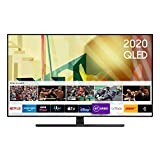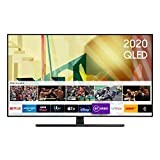Samsung Q70T/Q75T 4K QLED: An affordable next-gen gaming TV
Samsung has released a 4K QLED to suit practically every budget in 2020, but buying a cheaper model doesn’t necessarily mean you’re getting more value for your money. The Q70T/Q75T is a mid-range 4K QLED HDR TV that sits between the entry-level Q60T/Q65T and the more premium Q80T. Although it costs around £200 more than Samsung’s most basic QLED model, it’ll give you a lot more bang for your buck, adding in a higher refresh rate and a few next-gen gaming features that’ll help get the most out of the Xbox Series X and PS5.
Of course, the Q70T does lack some of the visual and audio niceties seen on Samsung’s more premium models. So, should you settle for the Q70T, or save up for something a little fancier?

|
Samsung Q70T: Key specifications |
|
Screen sizes available: |
55in QE55Q70TATXXU,65in QE65Q70TATXXU,75in QE75Q70TATXXU,85in QE85Q70TATXXU) |
|
Panel type: |
QLED (VA-type LED LCD) |
|
Resolution: |
4K/UHD (3,840 x 2,160) |
|
Refresh rate: |
120Hz |
|
HDR formats: |
HDR10, HDR10+, Hybrid-Log Gamma |
|
Audio enhancement: |
eARC (enhanced Audio Return Channel), Dolby Atmos, 5.1 Dolby Digital |
|
HDMI inputs: |
1 x HDMI 2.1, 3 x HDMI 2.0 |
|
Streaming services: |
Netflix, Disney Plus, Amazon Prime Video, BT Sport, Apple TV, Now TV, BBC iPlayer, ITV Hub, All 4, My5, YouTube etc. |
|
Tuners: |
Freesat HD, Samsung TV Plus |
|
Gaming features: |
VRR (FreeSync), ALLM, 4K@120Hz |
|
Wireless connectivity: |
Bluetooth 4.2, Wi-Fi 5 |
|
Smart platform: |
Tizen 5.5 |
|
Smart assistants: |
Samsung Bixby, Amazon Alexa, Google Assistant |
Samsung Q70T/Q75T: What you need to know
In name, the Samsung Q70T is the successor to the Samsung Q70R from 2019 but in terms of specifications, it’s actually more closely related to last year’s Q60R. The Q70T is available in numerous sizes, with 55in, 65in, 75in and 85in models on offer. Of those, the 85in is the only model to feature a two-legged stand design, whereas the others rest upon a central stand.
There’s also a variant of the Q70T exclusive to Currys PC World called the Q75T that comes in 55in, 65in and 75in sizes. The Q70T has a black stand while the Q75T’s stand is finished in silver. But that’s not where the differences end.
Despite the fact that these models have the same price tag, the Q75T actually has a slightly higher PQI (Picture Quality Index) than the Q70T, rated at 3500 versus 3400. However, it’s unlikely that viewers would be able to tell the picture quality of these TVs apart.
The Q70T has a 4K/UHD (3,840 x 2,160) VA-type LCD panel lit by LED edge-lighting. It’s a QLED display, which means that it has a layer of microscopic quantum dots in front of the LEDs that emit colour when they react to light, increasing the peak brightness of the display beyond standard LCD levels. Although Samsung popularised QLED, it is not a proprietary technology and nowadays QLED TVs are becoming increasingly affordable, especially those made by TCL and Hisense.
Whereas the Samsung Q60T is capped at 60Hz, the Q70T’s panel has a 120Hz refresh rate, and this potentially makes for smoother playback – be it a movie, show or game. The Q70T also benefits from the addition of Samsung’s Wide Viewing Angle film, a layer laid over the panel which improves the limited viewing angles inherent to VA-type LCD panels. It’s not quite as good as watching on an IPS or OLED display but it does dramatically improve contrast and vibrancy when you’re watching the TV at an angle.

However, the Q70T’s panel is at a disadvantage to the Q80T, which is the most affordable of Samsung’s QLEDs to incorporate FALD lighting, also known as Full-Array Local Dimming. That means that the Q80T’s backlighting is separated into numerous, independently controlled lighting zones, allowing for punchier images and fewer luminance fluctuations than you’d see on an edge-lit model like the Q70T. What’s more, the Q80T has Samsung’s Object Tracking Sound software, a new audio feature that attempts to replicate an immersive soundscape using only the TV’s speakers, without the need for a soundbar or surround sound setup.
On the bright side, the Q70T is the cheapest of Samsung’s 2020 QLEDs to come with an HDMI 2.1 input – you only get one, however, and the remaining three are HDMI 2.0. With HDMI 2.1, the Q70R has Variable Refresh Rate (VRR) and 4K 120Hz capabilities, two key gaming features supported by the PlayStation 5 and Xbox Series X.
As you’d expect, 4K 120Hz means that the panel can display a 4K signal at up to 120 frames per second. Meanwhile, VRR lets the panel match its refresh rate to the frame rate of the game, eliminating the ugly screen-tearing which can ruin the gaming experience on lesser sets. ALLM (Auto Low-Latency Mode) is also on hand, and automatically engages the TV’s low latency Game Mode when compatible consoles are connected in order to guarantee the fastest response times.
Like all of Samsung's 2020 4K QLEDs, the Q70T supports HDR10, Hybrid-Log Gamma and HDR10+ but not Dolby Vision. The lack of Dolby Vision is one of the main downsides of buying an HDR Samsung set because it’s the more popular of the dynamic HDR formats (the other being HDR10+).
The list of HDR10+ Blu-ray movies is extremely short compared to the vast library of discs with Dolby Vision, and major streaming services including Netflix and Disney Plus have sided with Dolby Vision too. However, you can still enjoy dynamic HDR playback on a variety of HDR10+ Amazon Prime titles.
Through Samsung’s own Tizen OS smart platform, the Q70T carries basically every streaming service in existence, including all of the free UK catch-up apps like BBC iPlayer. 2020 is the first year that Samsung TVs will support three smart assistants, namely Samsung Bixby, Amazon’s Alexa and Google Assistant. With three voice assistants at your disposal, you shouldn’t have any trouble finding your favourite shows and movies.
Samsung Q70T/Q75T: Price and competition
Though it launched at £1,099, the entry-level Samsung Q70T 55in has since come down in price to around £915 at Amazon , while the Q75T 55in (also with an RRP of £1,099) is available from Currys PC World for £999 . Naturally, prices shoot up as the size of the panel increases; the top-end Samsung Q70T 85in will set you back £2,499 from Samsung , and that’s after a recent £200 discount.
Samsung’s entry-level QLED, the Samsung Q60T , is a fair bit cheaper than the Q70T. The smallest 43in variant has been on sale for as little as £524 and the 55in model now goes for about £799 , a £200 reduction from its £999 launch price. If you can comfortably afford the Q70T but you’re tempted to buy a Q60T instead because it’s cheaper, we’d implore you to think again. With its 120Hz refresh rate, HDMI 2.1 capabilities and Wide Viewing Angle layer, the Q70T is much better value for money. Sure, it costs a little more, but in this case, a little goes a long way.
Alternatively, you could step up to the Q70T’s pricier sibling, the Samsung Q80T , which does everything the Q70T can and more. It’s the most affordable of Samsung’s 2020 QLEDs to benefit from Full-Array Local Dimming and it’s come down in price since launch, going for £1,099 . You could pick up an entry-level Q80T 49in for £999, but we wouldn’t recommend it: the 49in model only has a 60Hz refresh rate rather than 120Hz.
What about non-Samsung TVs? The Sony XH90 is a likeable mid-range LED LCD with Full-Array Local Dimming and excellent motion processing, and with upcoming HDMI 2.1 support (via a firmware update), it’s a great pick for would-be PS5 and Xbox Series X owners. We tested the 75in model (currently £400 off at £1,799) but you can bag the XH90 55in for only £999 – a healthy £300 off the RRP.
If you’d prefer an OLED over an LCD then your best bet in this price range would be the LG BX , the entry-level model in LG’s 2020 OLED lineup and the cheaper sibling to the LG CX , our favourite OLED of the year. Initially £1,399, the LG BX 55in now goes for around £1,199 . Like the Q70T and XH90, it’s got VRR and 4K 120Hz support for next-gen consoles, but also boasts the usual, astonishing OLED black levels, a higher contrast ratio and wider viewing angles than its LCD rivals.
Your comment